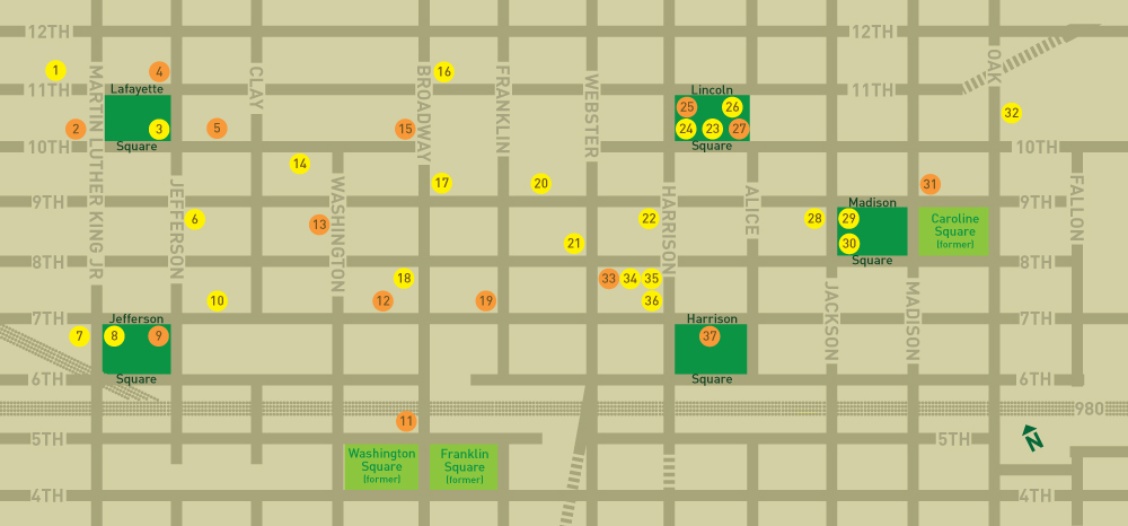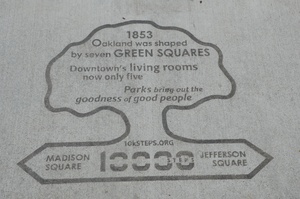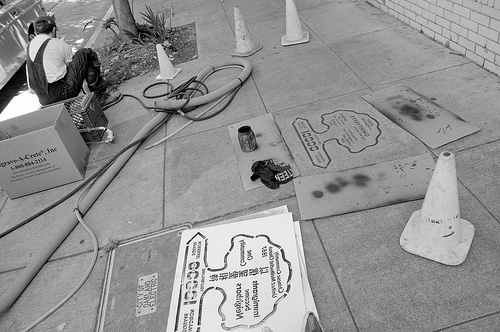 Walking the Invisible City map (At all of the yellow sites, you can hear neighbors’ stories about downtown Oakland’s layered history)
Walking the Invisible City map (At all of the yellow sites, you can hear neighbors’ stories about downtown Oakland’s layered history)
Walking the Invisible City includes 37 etched conversational sidewalk markers that encourage walkers to explore downtown Oakland and some of its oldest parks.
Oakland’s first city plan, drawn in 1853 by Julius Kellersberger, was framed by seven oak-filled squares.
Today, five of these squares continue to support the diverse communities who live nearby. Walking the Invisible City will lead you to these historic parks and vibrant neighborhoods. 1
 CC SA-BY Our Oakland
CC SA-BY Our Oakland
- 1869: Pardee Home, Governor & water advocate: George, First lady & eclectic collector: Helen, A living museum preserved by dedicated daughters.
-
Oakland's Mother Mary Ann Wright, Inspired by a vision, Sharing food & hope, In the park, she quietly changed the world.
-
1853: Oakland was shaped by seven green squares Downtown's living rooms, Now, only five 'Parks Bring out the goodness of good people.'
-
Oakland High School, Educated young minds here 1895-1928, Toppled in 1940, Its bricks built Lincoln Square's clubhouse.
-
1930s-1950s: Herbalist king Fong Wan, Provided miraculous cures, Doubted by mainstream medicine, "I am the light of the world!"
-
Housewives Market was Oakland, An ethnic food lifeline, East Bay's thriving shopping destination.
-
Their children loved this park, African American, Irish, Italian, and Latino neighbors, 1950s: Make way for the freeway! The last home standing.
-
1853: Oakland was shaped by seven green squares, Downtown's living rooms, Now, only five 'Parks Bring out the goodness of good people.'
-
Siete Cuadrados Verdes daban forma a Oakland De estos salones urbanos quedan solo cinco, Los parques hacen resaltar la bondad de buena gente 1853.
-
Oakland's first Latino Barrio, Tina Tamale: Guardian of cultural heritage, On cobblestoned La Siete.
-
1874: Main Street divided twin squares, Carpentier's power grab for young Oakland, The Alameda County Seat.
-
1875-1941: A transcontinental waiting room, Great Iron Horse tracks buried, Booming Oakland, Our multicultural city.
-
Once a Ratto's tradition: Wednesdays for pesto, Saturdays for pasta opera, A young Italian's quest, Bay Area's world food landmark since 1887.
-
Swan's Marketplace: Everything Under the Sun, Romantic Mr. Pantoskey's Free Market, 1885, Shrewd Mr. Swan's Dry Goods Salvage, 1924.
-
1983: Old Oakland's terrain updated, Dedicated to African American civic leader Scotlan, A devoted youth advocate.
-
Follow the trees, Walk among them, Urban secrets revealed... Discover your Invisible City.
-
Follow the trees, Walk among them, Urban secrets revealed... Discover your Invisible City.
-
Follow the trees, Walk among them, Urban secrets revealed... Discover your Invisible City.
-
Legendary underground passageways, Long ago… Seeking fortunes, games of chance: Pai Gow, Chinese Lottery, Fan Tan.
-
Chinatown's treasures: Sharing & Sustaining, Arts & Identity, The Oakland Asian Cultural Center, The Asian Branch Library.
-
1882-1943: Excluded, A forced Chinese sanctuary, A Bachelor society, Builders of California's infrastructure.
-
1922: A neo-gothic code machine factory, Never realized, On the top floor, Women of Chinatown, Sewed parachutes for WWII. (At the Asian Resource Center.)
-
A safe haven for youth, Mrs. Lee always listens, Park Mother, Peace keeper.
-
1853: Oakland was shaped, by seven green squares, Downtown's living rooms, Now, only five, 'Parks Bring out the goodness of good people.'
-
1898: A young sequoia grew, Nurtured by soil from each state, To honor Abraham Lincoln, the Great Emancipator.
-
1943: Dorothy Eng's Oak-Chi Center blossomed, Chinese daughters' worlds, "Our soldiers had somewhere to go." Hospitality & Friendship.
-
1969: Wa Sung Community Service Club's gift, 'Free China' junk ship, A symbol of determination, For children everywhere.
-
1942: Executive Order 9066, Shattered Japantown, This Buddhist Church, A reminder of that history, "I am an American!"
-
1965: A BART land exchange. A daily morning sea of movement, Hundreds flow together, "Tai Chi Park is our dream."
-
1853: Oakland was shaped, by seven green squares, Downtown's living rooms, Now, only five, 'Parks Bring out the goodness of good people.'
-
1853: Over cattle trails, Kellersberger mapped wide urban streets, And included Caroline Square here, So named for his dear wife.
-
OMCA, Transform (in Ohlone, Spanish, Chinese, English), Once, A lush marsh & oak woodlands, Oakland's original eastern edge.
-
1887: Chinese Community United Methodist Church, Faith, hope, love at work, Immigrants become neighbors, One community.
-
Lon Yoke Fong, Our "Fong Get Mo," A trim…a lollipop…even a myna bird! Chinatown's Queen Barber, 1940s-1980s.
-
Defenders of civil rights, Hurdling social & political barriers, From here since 1912, The Chinese American Citizens Alliance, Oakland Lodge.
-
A nostalgic park, Linked to Oakland's pioneer days. A past Railroad Museum, Now honors, Local Chinese-American heroes.
-
1853: Oakland was shaped, by seven green squares, Downtown's living rooms, Now, only five, 'Parks Bring out the goodness of good people.'
Through a unique style of stewardship, 10,000 Steps (2006-10) explored downtown Oakland’s historic parks. These parks—Jefferson Square, Lafayette Square, Madison Square, and Lincoln Square, each occupying only one city block—are tiny spots of open space in the urban fabric, places where tai chi practitioners, men gathering for a pick-up game of basketball, kids in after-school programs, mothers with strollers, and the homeless all come together.
10,000 Steps culminated in a permanent meandering neighborhood narrative, Walking the Invisible City. This looped walk, marked with permanent conversational sidewalk stepping stones, reveals the city within the city: hidden local lore, architectural and cultural history, and points of urban transformation all centered around these four historic parks. This anthropological stewardship effort has revived and preserved multi-layered stories to engage pedestrians with Oakland’s changing cityscape. 2
Pages tagged “10000 Steps”
 Bruce Douglas, co-founder of the "10,000 Steps" project, paints a little bit of history on sidewalks around Oakland, CA. photo CC BY-NC-ND 2.0 by Desmond Henderson
Bruce Douglas, co-founder of the "10,000 Steps" project, paints a little bit of history on sidewalks around Oakland, CA. photo CC BY-NC-ND 2.0 by Desmond Henderson
Links and References
- Walking the Invisible City (on archive.org)
- 10,000 Steps Oakland (on archive.org)



